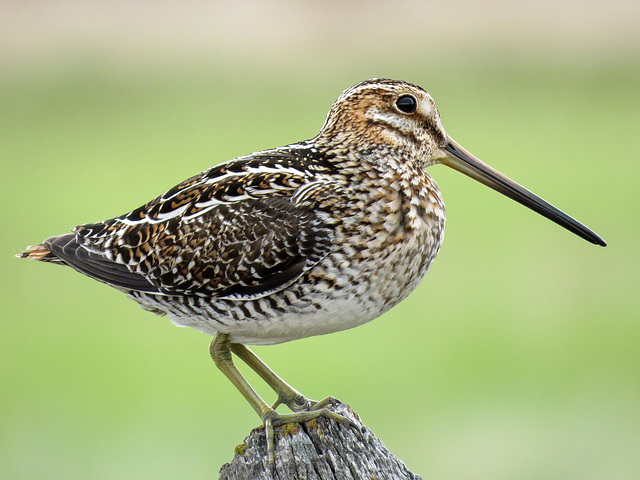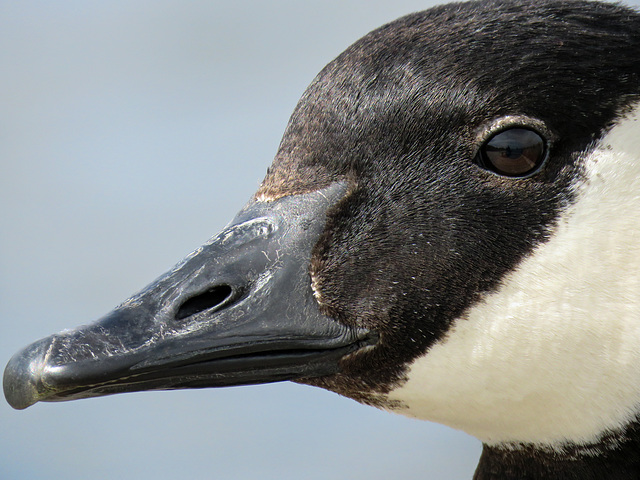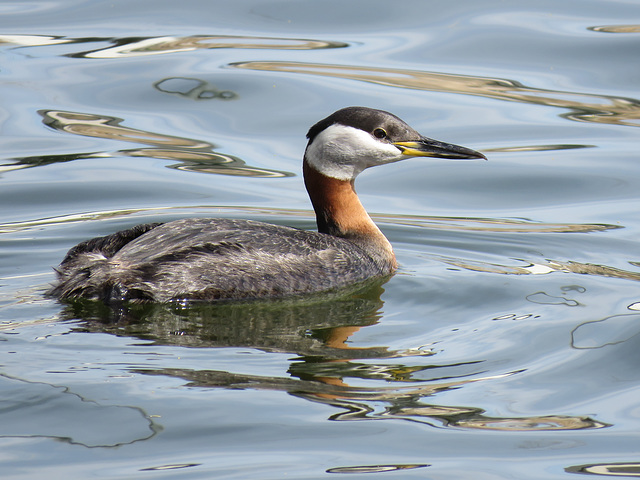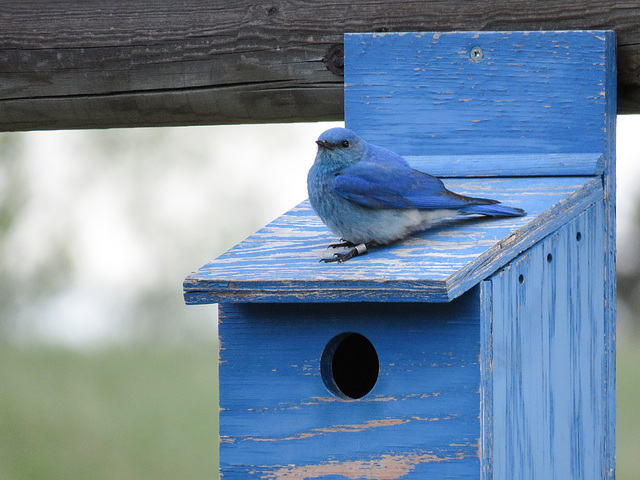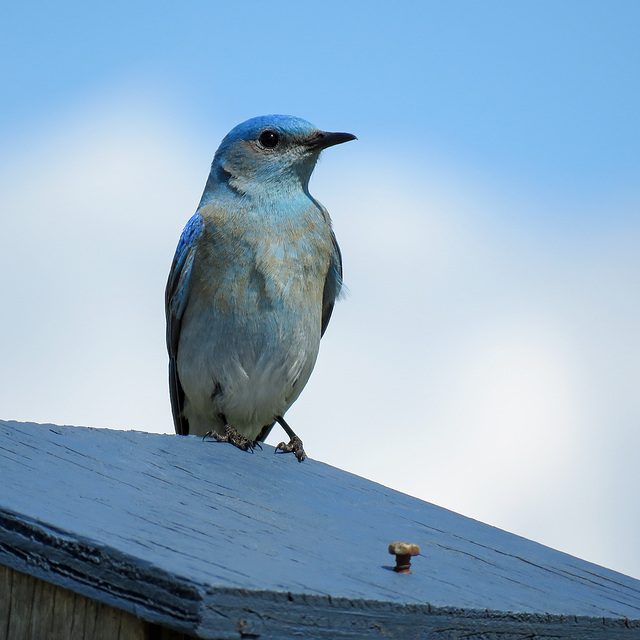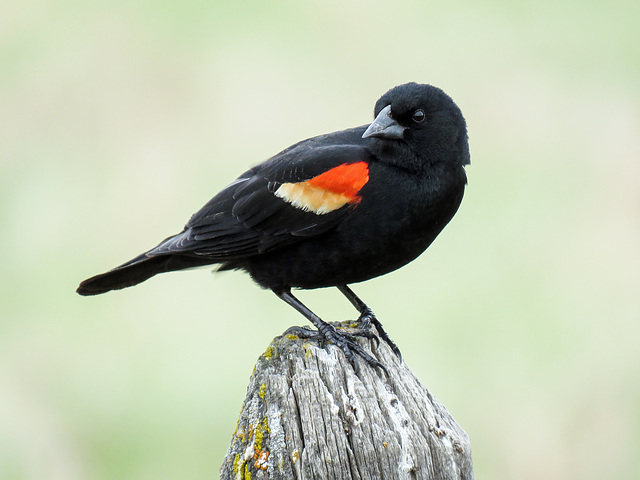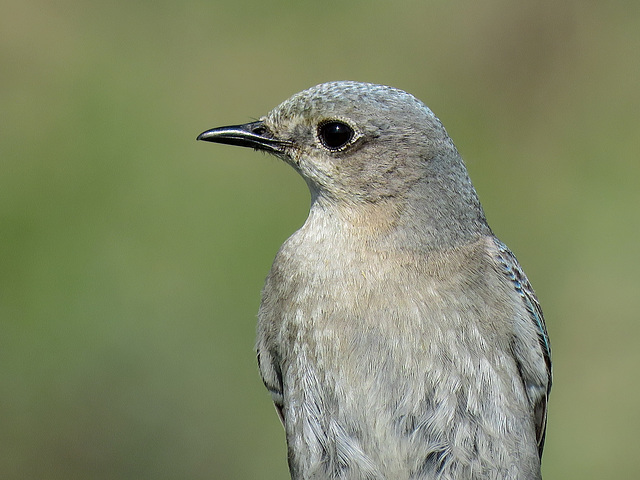
Canon SX60
05 May 2017
2 favorites
Wilson's Snipe
Late yesterday afternoon, 5 May 2017, I dragged myself away from my computer and went for just a short drive SW of the city. The weather forecast was for sun and cloud, but it was far too cloudy for good light. I was hoping to see Mountain Bluebirds, but I only saw a couple of them and they were in flight. A Wilson's Snipe, one of my favourite birds to see and photograph, was already there, perched on a fence post, so I came home happy. This photo was taken form driver's seat, looking through passenger seat window. Why do newer vehicles have a huge console in the front, so that one can't slide across to the other seat?! Manufacturers need to be considerate to Birders, lol!
"Though the long tradition of “snipe hunt” pranks at summer camp has convinced many people otherwise, Wilson’s Snipes aren’t made-up creatures. These plump, long-billed birds are among the most widespread shorebirds in North America. They can be tough to see thanks to their cryptic brown and buff coloration and secretive nature. But in summer they often stand on fence posts or take to the sky with a fast, zigzagging flight and an unusual “winnowing” sound made with the tail." From AllAboutBirds.
www.allaboutbirds.org/guide/Wilsons_Snipe/id
According to Fisher and Acorn's book, "Birds of Alberta", "the common Snipe is both secretive and well camouflaged, so few people notice it until it flushes suddenly from a nearby grassy tussock. As soon as the Snipe takes to the air, it performs a series of quick zigzags - an evasive maneuver designed to confuse predators. Because of this habit, Snipes were among the most difficult birds to shoot (in the days when shorebirds were hunted for sport), and skilled sportsmen were known as "snipers" - a term later adopted by the military."
youtu.be/Z16CUdX2g5Q
It feels good to take a short break from going through my Trinidad & Tobago photos - not to mention posting them! - but I know I must plod on. Today, I will start going though Day 6 of our 8-day trip (plus two travel days). This day includes a wonderful hot lunch at the beach, which we so enjoyed. More new birds, whose names I have already forgotten, so I will have to look them up. New plants, including beautiful Water Hyacinth and the amazing Sacred Lotus (which I had only ever seen growing in the Conservatory at the Calgary Zoo). I love photographing their spectacular seedpods.
For now, though, I must have breakfast/brunch - with a small sprinkling of chocolate powder, bought on Day 5 of our Trinidad trip, over my Stoked Oats. Then, back to editing ....
11 May 2017
Up close and personal
The last 7 images that I have just uploaded were taken yesterday afternoon, 11 May 2017, at a pond in Calgary. This Canada Goose came near me, not the other way round. Much as I would rather not interrupt my Trinidad photos, I did want to post these local birds and plants, otherwise I might forget. Sorry that I have added so many photos, and at such a fast rate! Seeing my calendar filling up rather quickly, I know that I will be getting various chances to take photos, and it would help greatly if I can get my holiday photos finished.
This morning, I finished the last few photos taken at Manzaniila Beach, Trinidad. From there, we drove the Nariva Swamp area, which is mainly agricultural habitats with some wetlands. Some good birding there and I will be posting various new species. Also, at least a couple of plants that we enjoyed seeing, especially the Sacred Lotus. This is one of my favourite things to photograph in the Conservatory at the Calgary Zoo.
11 May 2017
Mallard female
HAPPY MOTHER'S DAY!
In Canada, this is celebrated each year on the second Sunday of May. Of course, every day should be Mother's Day.
The two photos I have just posted this morning, 14 May 2017, were taken three days ago, on 11 May 2017, at a pond in Calgary. Just a short drive and a quick visit. Much as I don't like interrupting my Trinidad & Tobago images, I did want to add these local photos, otherwise I might forget. Seeing my calendar filling up rather quickly, I know that I will be getting various chances to take photos, and it would help greatly if I can get my holiday photos finished. Tonight, I will hopefully add a few more photos from my trip.
"If someone at a park is feeding bread to ducks, chances are there are Mallards in the fray. Perhaps the most familiar of all ducks, Mallards occur throughout North America and Eurasia in ponds and parks as well as wilder wetlands and estuaries. The male’s gleaming green head, gray flanks, and black tail-curl arguably make it the most easily identified duck. Mallards have long been hunted for the table, and almost all domestic ducks come from this species." From AllAboutBirds.
Occasionally, Mallards have been known to show up in people’s swimming pools. My good friend, Art (Leapfrog), has had more than 45 on his pool at any given time. His pool is covered, with a layer of water on top of the cover. One special pair, Daisy and Donald, have been coming to his backyard pool for at least 11 or 12 years!
www.allaboutbirds.org/guide/Mallard/id
en.wikipedia.org/wiki/Mallard
11 May 2017
2 favorites
1 comment
Red-necked Grebe / Podiceps grisegena
HAPPY MOTHER'S DAY!
In Canada, this is celebrated each year on the second Sunday of May. Of course, every day should be Mother's Day.
The two photos I have just posted this morning, 14 May 2017, were taken three days ago, on 11 May 2017, at a pond in Calgary. Just a short drive and a quick visit.
Much as I don't like interrupting my Trinidad & Tobago images, I did want to add these local photos, otherwise I might forget. Seeing my calendar filling up rather quickly, I know that I will be getting various chances to take photos, and it would help greatly if I can get my holiday photos finished. Tonight, I will hopefully add a few more photos from my trip.
I love seeing these Red-necked Grebes, though they tend to be rather distant when I do see them. Most of the time, they just look so quietly elegant while they swim.
"The Red-necked Grebe breeds on small inland lakes in Canada and Alaska, and winters along both coasts of North America. Boldly marked, vocal, and aggressive during the breeding season, it is quiet and subtly attired in winter.
Like other grebes, the Red-necked Grebe ingests large quantities of its own feathers. Feathers remain in the bird's stomach. The function of feathers in the stomach is unknown. One hypothesis suggests that the feathers help protect the lower digestive tract from bones and other hard, indigestible material. The Red-necked Grebe also feeds its feathers to its young.
The Red-necked Grebe migrates over land strictly at night. It sometimes migrates over water or along coasts by day, in large flocks.
The oldest recorded Red-necked Grebe was at least 11 years old when it was found in Minnesota, the same state where it had been banded." From AllABoutBirds.
www.allaboutbirds.org/guide/Red-necked_Grebe/id
20 May 2017
1 favorite
A house to match
Well, I'm certainly not getting on very well with my Trinidad photos at the moment : ) Other things keep popping up and they have offered photo opportunities, too. This morning, I have just posted seven more shots from my day out with four friends, driving the area SW of Calgary, on 20 May 2017.
Part of the morning was spent at our friend, Barb's, acreage, SW of Calgary, enjoying the variety of birds that visit her garden. Thanks so much, Barb, as always, for letting us visit you. Such a joy to see birds like the handsome male Rose-breasted Grosbeak and the Evening Grosbeaks. I so rarely get to see either of these birds. Loved the way this little Mountain Bluebird male chose the blue nesting box.
In Bluebirds, the blue colour is produced by the structure of the feather - there is no blue pigment. "Tiny air pockets in the barbs of feathers can scatter incoming light, resulting in a specific, non-iridescent color. Blue colors in feathers are almost always produced in this manner. Examples include the blue feathers of Bluebirds, Indigo Buntings, Blue Jay's and Steller's Jays."
www.allaboutbirds.org/guide/Mountain_Bluebird/id
www.jstor.org/discover/pgs/index?id=10.2307/4077277&i...
We then drove the various roads SW of the city, as far south as Turner Valley, hoping to see a few birds. Beautiful scenery in the whole area. In Turner Valley, we called in to see another mutual friend and watch the birds that visited her tiny, but beautifully and thoughtfully designed, back deck. Thanks so much for having us - and for the most welcome coffee! - Jackie, especially at such very short notice!
20 May 2017
2 favorites
A nest box to match
I would imagine every Flickr member received this email today:
"If you haven’t heard, Yahoo plans to sell its operating business, including Flickr, to Verizon Communications Inc. We anticipate the completion of the transaction to occur in June 2017. Upon the completion of this proposed transaction, Yahoo products and services, including Flickr, will be provided by a new Verizon-owned company called Yahoo Holdings, Inc.
In connection with this proposed transaction, Yahoo is updating its Terms of Service. You can review the changes by visiting our Terms of Service
These updated terms will automatically be effective on June 8, 2017, unless you cancel your Yahoo account before then.
That’s it! We look forward to continuing to deliver your favorite products and services."
------------------------------------------------------------------------------------------------
What a huge loss very early yesterday morning (22 May 2017), when the beautiful old mission church west of Cochrane, McDougall Church, burned down! This was a place that I loved to visit and photograph - a place with such an interesting and important history. I will add the link to my McDougall Church album for anyone who is interested. Thanks to my daughter for letting me know about this very sad news.
www.cochranenow.com/local/fire-leaves-many-with-heavy-hearts
www.flickr.com/photos/annkelliott/albums/72157645848592486
------------------------------------------------------------------------------------------------
Well, I'm certainly not getting on very well with my Trinidad photos at the moment : ) Other things keep popping up and they have offered, or will be offering, photo opportunities, too. This morning, I have just posted seven more shots from my day out with four friends, driving the area SW of Calgary, on 20 May 2017.
Part of that morning was spent at our friend, Barb's, acreage, SW of Calgary, enjoying the variety of birds that visit her garden. Thanks so much, Barb, as always, for letting us visit you. Such a joy to see birds like the handsome male Rose-breasted Grosbeak and the Evening Grosbeaks. I so rarely get to see either of these birds.
We then drove the various roads SW of the city, as far south as Turner Valley, hoping to see a few birds. Beautiful scenery in the whole area. In Turner Valley, we called in to see another mutual friend and watch the birds that visited her tiny, but beautifully and thoughtfully designed, back deck. Thanks so much for having us, Jackie - and for the most welcome coffee! - especially at such very short notice!
On my way home from this enjoyable day out, I drove a few backroads, looking for any Mountain Bluebirds. Found this male perched atop his box, which matched his colour very nicely.
In Bluebirds, the blue colour is produced by the structure of the feather - there is no blue pigment. "Tiny air pockets in the barbs of feathers can scatter incoming light, resulting in a specific, non-iridescent color. Blue colors in feathers are almost always produced in this manner. Examples include the blue feathers of Bluebirds, Indigo Buntings, Blue Jay's and Steller's Jays."
www.allaboutbirds.org/guide/Mountain_Bluebird/id
www.jstor.org/discover/pgs/index?id=10.2307/4077277&i...
This coming weekend, it is the annual May Species Count. This year, 2017, I am only going to be doing the Sunday Count - no walking : )
"The count goes May 27-28: Calgary birders have been out in force every May since 1979, contributing to a broad census of the constantly changing patterns of bird distributions in North America. Last year (2015) we found 212 species. The count circle is the same as previous years, extending from Olds to Nanton, and from Exshaw to Standard, and includes a variety of environments." From NatureCalgary.
05 May 2017
2 favorites
Red-winged Blackbird male
Late afternoon on 5 May 2017, I dragged myself away from my computer and went for just a short drive SW of the city. The weather forecast was for sun and cloud, but it was far too cloudy for good light. I was hoping to see Mountain Bluebirds, but I only saw a couple of them and they were in flight. A Wilson's Snipe, one of my favourite birds to see and photograph, was already there, perched on a fence post, so I came home happy. A few Red-winged Blackbirds were being their very vocal selves, including this one, whose shoulder patches of colour were quite large and vibrant, making him more attractive to the females.
"One of the most abundant birds across North America, and one of the most boldly colored, the Red-winged Blackbird is a familiar sight atop cattails, along soggy roadsides, and on telephone wires. Glossy-black males have scarlet-and-yellow shoulder patches they can puff up or hide depending on how confident they feel. Females are a subdued, streaky brown, almost like a large, dark sparrow. In the North, their early arrival and tumbling song are happy indications of the return of spring." From AllAboutBirds.
www.allaboutbirds.org/guide/Red-winged_Blackbird/id
28 May 2017
A slight touch of blue
Just adding five extra photos tonight, trying to catch up a little, otherwise I will never get back to the last two days of my Trinidad images. Will post three photos tomorrow morning.
This photo shows a female Mountain Bluebird, far less colourful than the male. She still has a very faint wash of colour on some of her feathers.
In Bluebirds, the blue colour is produced by the structure of the feather - there is no blue pigment. "Tiny air pockets in the barbs of feathers can scatter incoming light, resulting in a specific, non-iridescent color. Blue colors in feathers are almost always produced in this manner. Examples include the blue feathers of Bluebirds, Indigo Buntings, Blue Jay's and Steller's Jays."
www.allaboutbirds.org/guide/Mountain_Bluebird/id
www.jstor.org/discover/pgs/index?id=10.2307/4077277&i...
What a great day our group of four people had on 28 May 2017, taking part in the annual May Species Count. We travelled in just one car, which worked out well. On the 2016 May Species Count, we had been unable to find a Great Gray Owl, but I drove back to the area the next day, and found two of them. No matter how many times I see one of these owls and no matter how many hundreds/thousands of photos I've taken of them, each owl is just as exciting as the very first. So, it was a thrill to again see one of these spectacular owls.
The owl was on a fence post when we first saw it. As is usually the case with these owls, it was focused on finding a Meadow Vole for a snack and in fact did catch one while I was watching. It moved to a few different fence posts in its search. Once it had caught its prey, it ate it there, down on the ground - with its back to us, of course. I was kind of hoping it would fly back up to the fence with it, but it didn't.
While I was taking photos, various people came along the road, a couple in cars, but most were cyclists out for a long ride on such a beautiful, sunny day. The owl basically ignored everyone, giving just a quick glance at us every once in a while. Their concentration never fails to leave me in awe.
We found 72 bird species - amazing, really. Three pairs of great eyes - plus me : ) Part of our Count covers some of my favourite roads, so it is not surprising that I enjoy it so much. Once the Count had finished, I drove a few of the roads again on my way home, mainly focusing on two pairs of Mountain Bluebirds that I had enjoyed watching last year. Needless to say, I went home feeling very happy after a long day of birding, and oh, so tired!
28 May 2017
3 favorites
5 comments
Showing off all his "bling"
Last night, I added five extra photos, trying to catch up a little, otherwise I will never get back to the last two days of my Trinidad images. I am posting three more photos this morning.
In Bluebirds, the blue colour is produced by the structure of the feather - there is no blue pigment. "Tiny air pockets in the barbs of feathers can scatter incoming light, resulting in a specific, non-iridescent color. Blue colors in feathers are almost always produced in this manner. Examples include the blue feathers of Bluebirds, Indigo Buntings, Blue Jay's and Steller's Jays."
www.allaboutbirds.org/guide/Mountain_Bluebird/id
www.jstor.org/discover/pgs/index?id=10.2307/4077277&i...
I do prefer to photograph Bluebirds that have no bands on them, but the ones I usually see do have a band. This particular male was being studied and the person involved used brightly coloured bands so that she (he?) didn't need to approach the bird closely in order to tell which individual it was. I don't know if all the bands were added at the same time or not. I don't like to see that many, wondering how much their weight might affect the bird. I photographed this male a year ago at the same location, too, and he seems to be just fine. I'm always amazed how any bird can fly to warmer places for the winter and then find its way back to an exact spot. Wish my sense of direction was that good, instead of being almost non-existent!
What a great day our group of four people had on 28 May 2017, taking part in the annual May Species Count. We travelled in just one car, which worked out well. On the 2016 May Species Count, we had been unable to find a Great Gray Owl, but then I drove back to the area the next day, and found two of them. No matter how many times I see one of these owls and no matter how many hundreds/thousands of photos I've taken of them, each owl is just as exciting as the very first. So, it was a thrill yesterday to see one of these spectacular owls - seen in previous photo posted today.
This Count's owl was on a fence post when we first saw it. As is usually the case with these owls, it was focused on finding a Meadow Vole for a snack and in fact did catch one while I was watching. It moved to a few different fence posts in its search. Once it had caught its prey, it ate it there, down on the ground - with its back to us, of course. I was kind of hoping it would fly back up to the fence with it, but it didn't.
While I was taking photos, various people came along the road, a couple in cars, but most were cyclists out for a long ride on such a beautiful, sunny day. The owl basically ignored everyone, giving just a quick glance at us every once in a while. Their concentration never fails to leave me in awe.
My small group found 72 species of bird on this 2017 Count - amazing, really. Three pairs of great eyes - plus me : ) Part of our Count covers some of my favourite roads, so it is not surprising that I enjoy it so much. Once the Count had finished, I drove a few of the roads again on my way home, mainly focusing on two pairs of Mountain Bluebirds that I had enjoyed watching last year. The male in this photo has four different bands on its legs, more than one usually sees. Needless to say, I went home feeling very happy after a long day of birding, and oh, so tired!
Two days later, on 30 May 2017, I was out for the day south of the city with my Daughter (a belated day out for my birthday and Mother's Day), to Nanton and a few roads nearby and then making our way to Frank Lake and finally ending up at the Saskatoon Farm, where we decided to have an early supper. My favourite kind of day, so thank you, Rachel, as always!!
Jump to top
RSS feed- Latest items - Subscribe to the latest items added to this album
- ipernity © 2007-2024
- Help & Contact
|
Club news
|
About ipernity
|
History |
ipernity Club & Prices |
Guide of good conduct
Donate | Group guidelines | Privacy policy | Terms of use | Statutes | In memoria -
Facebook
Twitter

